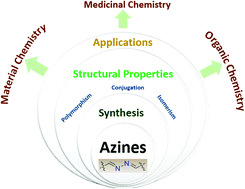Azines: synthesis, structure, electronic structure and their applications†
Abstract
Azines are organic molecules which bear the C![[double bond, length as m-dash]](https://www.rsc.org/images/entities/char_e001.gif) N–N
N–N![[double bond, length as m-dash]](https://www.rsc.org/images/entities/char_e001.gif) C functional unit. In the recent past, azines have received increased attention due to the recognition of their biological, chemical and materials properties. Azines have been conventionally synthesised by the condensation of hydrazine with ketones and aldehydes, and many alternate routes are also available. Azines have been extensively studied to investigate the presence or absence of conjugation with the help of computational studies and crystal structure analysis owing to their importance in nonlinear optics. The tautomerism in azines is a topic of contemporary interest. Herein, we present a review of recent advances in the structure and electronic structure properties of azines along with information on the modern methods of their synthesis and application as precursors in generating heterocycles in organic synthesis and in medicinal chemistry. A few applications of azines in the field of materials chemistry in developing metal–organic frameworks (MOFs), covalent organic frameworks (COFs), energetic materials and chemosensors are also included.
C functional unit. In the recent past, azines have received increased attention due to the recognition of their biological, chemical and materials properties. Azines have been conventionally synthesised by the condensation of hydrazine with ketones and aldehydes, and many alternate routes are also available. Azines have been extensively studied to investigate the presence or absence of conjugation with the help of computational studies and crystal structure analysis owing to their importance in nonlinear optics. The tautomerism in azines is a topic of contemporary interest. Herein, we present a review of recent advances in the structure and electronic structure properties of azines along with information on the modern methods of their synthesis and application as precursors in generating heterocycles in organic synthesis and in medicinal chemistry. A few applications of azines in the field of materials chemistry in developing metal–organic frameworks (MOFs), covalent organic frameworks (COFs), energetic materials and chemosensors are also included.



 Please wait while we load your content...
Please wait while we load your content...